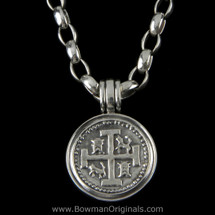Posted by Bowman Originals on Jul 26th 2025
The Evolution of Men's Jewelry

The Origin, History, and Evolution of Men Wearing Jewelry
Jewelry has long been a symbol of power, status, spirituality, and self-expression—and men have worn it since the earliest chapters of civilization. From ancient kings and warriors to contemporary celebrities and creatives, jewelry has always told a story. Today, modern men are rediscovering its timeless appeal, blending heritage with individuality in bold, elegant ways.
Ancient Beginnings: Power, Protection, and Prestige
Archaeological evidence reveals that men were among the earliest wearers of jewelry. In ancient Egypt, pharaohs adorned themselves with lavish gold collars, scarab rings, and ceremonial cuffs—not merely for beauty, but as talismans of divine authority. In Mesopotamia and Persia, men wore intricately engraved cylinder seals on necklaces or belts, often made of lapis lazuli and other precious stones.
In ancient Rome, signet rings marked the identity of noblemen and were used to seal documents with wax. Similarly, Celtic warriors wore bronze torcs around their necks to signify honor, strength, and social rank.
The Middle Ages to the Renaissance: Sacred and Symbolic
Throughout the Middle Ages, European royalty and clergy alike embraced jewelry as a mark of religious devotion and dynastic wealth. Cross pendants, jeweled brooches, and ecclesiastical rings adorned bishops and monarchs alike. During the Renaissance, the flourishing of the arts led to an explosion of decorative men's jewelry—often boasting heraldic symbols, cameos, and gemstones cut with increasing precision.
The 18th–19th Century: Restraint and Refinement
As men's fashion grew more tailored and restrained in the 18th and 19th centuries, so too did jewelry. Ornate styles gave way to functional adornments—think pocket watch chains, tie pins, and engraved cufflinks. Rings, often monogrammed or bearing family crests, remained a staple of male elegance and social standing.
The 20th Century: Rebellion and Reinvention
In the mid-20th century, men's jewelry made a dramatic return—not as a symbol of class, but as a tool of rebellion and self-expression. Elvis Presley wore pinky rings and gemstone-studded belts with unapologetic flair. Jimi Hendrix layered necklaces, scarves, and rings as part of his psychedelic signature. Later, hip-hop artists like Tupac Shakur and Jay-Z redefined jewelry as a badge of success, independence, and cultural pride.
Icons like Keith Richards and Johnny Depp brought back bohemian masculinity through skull rings, leather cuffs, and silver talismans—while David Bowie used jewelry as part of his ever-shifting identity, blurring the lines of gender, genre, and glamour. Browse Handmade jewelry by Bowman Originals
Today: Jewelry as Identity
In the 21st century, the boundaries have dissolved. Actors like Timothée Chalamet, musicians like Harry Styles, and athletes like LeBron James are leading a jewelry renaissance. From layered pearl necklaces and signet rings to diamond earrings and gemstone pendants, men today are choosing pieces that speak to emotion, heritage, and artistry—not just utility.
Social media and global fashion have helped normalize—and even celebrate—men’s jewelry as a deeply personal form of adornment. Whether minimalist or bold, symbolic or sentimental, jewelry is now a natural extension of modern masculine style. Learn about Bowman Originals jewelry
Legacy Meets Expression
At Bowman Originals, we honor this evolving narrative by crafting heirloom-quality jewelry for men who appreciate both tradition and self-expression. From handcrafted sterling silver rings and 18k gold pendants to gemstone-accented cufflinks and statement chains, each piece is made to last—designed with legacy in mind and individuality at heart.
